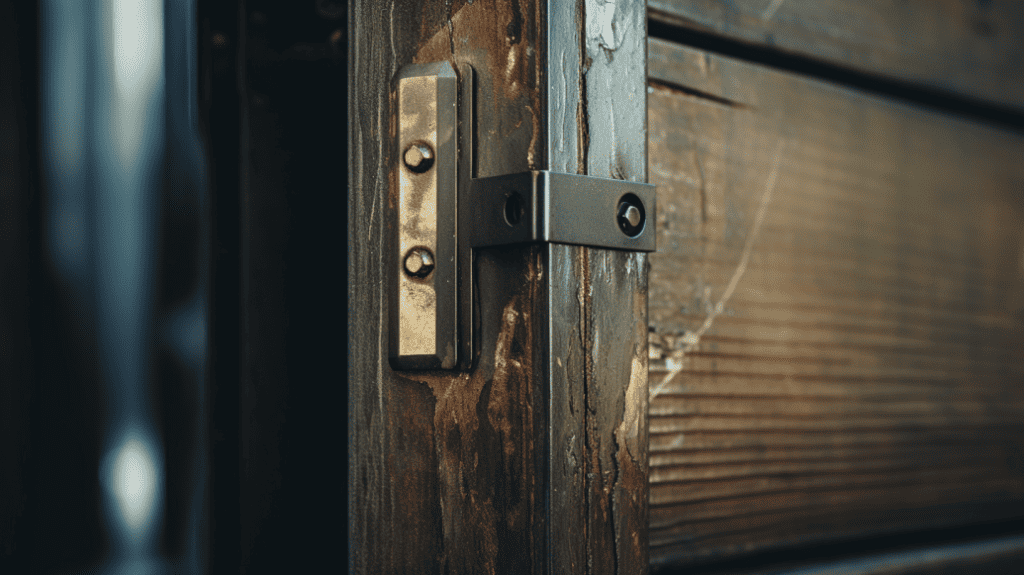
A door jamb is a vital component of any door frame. The vertical portion forms the door opening and allows the door to swing open and closed. The thickness of the wood on a door jamb can vary depending on the type of wall construction and door being installed. Here is a comprehensive guide to door jamb thickness.
What is a Door Jamb?
A door jamb refers to the vertical pieces of a door frame that create the door opening. The jamb forms the sides and head of the frame.
Key elements of a door jamb include:
- Stop – The wood strip along the jamb that stops the door from swinging through the frame. It covers the gap between the door and the jamb.
- Rabbet – The recess cut along the back inner edge of the jamb to receive the door. The depth of the rabbet determines the door thickness that can be accommodated.
- Hinge gaining – The mortises cut into the jamb to receive the hinge leafs and allow the door to swing.
- Strike gaining – The mortise cut into the jamb to receive the strike plate for the latch/lockset.
Standard Door Jamb Sizes
The most common interior door jamb thickness is:
- 4-5/8 inches – This standard jamb thickness is designed for 2×4 framed walls with 1/2 inch drywall. It leaves 1/8 inch clearance between the jamb and drywall.
Other typical interior jamb widths include:
- 4-9/16 inches – For 2×4 framing with 1/2 inch drywall
- 5-1/2 inches – For 2×4 framing with 5/8 inch or thicker drywall
- 6-9/16 inches – For 2×6 framing or masonry walls
Thicker jambs are also used on exterior doors and soundproof doors.
Measuring for Door Jamb Size
To determine the correct jamb thickness for your existing framed opening:
- Remove any casing or trim moulding.
- Measure across the opening from the edges of the existing jamb.
- Add 1/8 to 1/4 inch to this measurement to account for drywall/sheathing thickness.
- Select the nearest standard jamb size equal to or greater than your measured width.
For example, if you measure 4-3/4 inches across, you would order a 4-9/16 inch jamb.
Adjustable Door Jambs
Many pre-hung door units come with split jambs that allow them to accommodate varying wall thicknesses:
- The jamb is split into two pieces.
- Shims of varying thickness can be used between the pieces to adjust the overall jamb width.
- The two pieces lock together with interlocking shoulders.
This allows a single jamb to be adjusted for framed walls or masonry openings from 4-1/2 to 9-1/2 inches thick.
Typical Thickness by Door Type
Interior Doors
- Hollow core slab doors – 4-5/8″ jamb
- Solid wood slab doors – 4-5/8″ jamb
- Solid wood stile and rail doors – 4-5/8″ or thicker jamb
- Interior pre-hung units – 4-5/8″ or adjustable split jamb
Exterior Doors
- Fiberglass and steel exterior doors – 4-9/16″, 5-1/2″ or thicker jamb
- Wood exterior doors – 5-1/2″ or thicker jamb
- External pre-hung units – 5-1/2″ or thicker jamb
Pocket Doors
- Single pocket doors – 4-5/8″, 5-1/2″ or wider jamb
- Double pocket doors – 5-1/2″ or thicker jamb
Thicker jambs add stability for heavier doors.
Fire Rated Doors
- 20-minute rating – 5-1/2″ solid core wood jamb
- 45-90 minute ratings – 8-3/4″, 9-5/8″, or equal to wall thickness metal jamb
Soundproof Doors
- Wood soundproof doors – 7-1/8″, 8-3/4″, thicker custom jamb
- Metal soundproof doors – Equal to wall thickness jamb
Door Jamb Components

A typical door jamb consists of:
- Head jamb – The horizontal jamb forms the top of the opening.
- Hinge jamb – The vertical jamb with hinge mortises on doors with hinges.
- Strike jamb – The vertical jamb with the strike mortise and stop.
- Sill – The horizontal bottom piece on exterior doors.
On interior doors, the head jamb may be a simple head casing versus a thick structural part.
The strike jamb takes the most force and is usually wider than the hinge jamb on exterior doors.
Materials Used for Door Jambs
Standard door jamb materials include:
- Wood – Pine, oak, and mahogany are typical. Oak or mahogany provide the best quality and durability.
- Wood composites – Engineered wood like finger-jointed pine and laminated veneer lumber (LVL) are low-cost options.
- Metal – Galvanized steel and extruded aluminium jambs offer high strength. They are required for high ratings.
- PVC/Vinyl – Plastic jambs offer durability and low maintenance for exterior use.
- Fiberglass – Fiberglass jambs provide similar benefits to vinyl. They are used on fibreglass doors.
Wood jambs can be painted or stained to match door trims. Composite, vinyl, and fibreglass jambs are only available primed/white.
Rabbet Depth
The door thickness determines the rabbet depth needed:
- 1-3/8″ doors require a 1-3/8″ rabbet
- 1-3/4″ doors require a 1-3/4″ rabbet
- Thicker doors require deeper rabbets
If the existing jamb rabbet is not deep enough for the new door, it can be modified by cutting out additional material.
Hinge Gaining
The hinge-gaining mortises on the hinge jamb must match the hinge preparation on the new door.
If the new hinges are a different size than the existing cutouts, the jamb will need to be modified. They are filling the old mortises and cutting new ones to match the door hinge preparation.
Strike Gaining
As with the hinge cutouts, the strike jamb mortise must match the required preparations for the new lockset or latchset.
The height of the mortise must align with the strike plate on the door. The mortise width and depth must fit the new strike plate.
Stop Width
The stop on the jamb overlaps the door to close off the gap to the rabbet.
Typical stop widths are:
- 1/2 inch – For lightweight interior doors
- 5/8 to 3/4 inch – For heavier solid wood doors
- 1 inch – For exterior doors and soundproof doors
Wider stop widths provide more weatherproofing and acoustic sealing but reduce the clear door opening width.
Jamb Extensions
If the existing wall rough opening is wider than the new jamb, filler strips or jamb extensions will need to be added to close the gap to the wall.
This helps shim the jamb and provides solid blocking for casing trims.
Cased Openings vs Pre-Hung Jambs

There are two main jamb installation methods:
Cased opening:
- Jambs nailed vertically to studs.
- Separate trim casing installed overlapping the wall and jambs.
Pre-hung jamb:
- The entire frame is pre-assembled with stop mouldings.
- Frame nails through jamb edges into studs.
Pre-hung units are easier to install but limit trim profiles to what is factory-applied.
Installing New Jambs in an Existing Wall Opening
The general procedure for installing new jambs is:
- Remove existing door, jambs, trim, and wall coverings back to the studs.
- Cut the rough opening wider if needed to allow fitting the new thicker jambs.
- Cut new jambs to the height of the opening.
- Install jambs plumb and square in the opening.
- Shim jambs as needed to fill gaps.
- Anchor jambs securely to studs.
- Install door in jamb.
- Install exterior weather barrier and flashing (for exterior doors).
- Install interior trims or reinstall existing trims.
- Complete finish work and seal around jambs.
The process takes careful measuring, fitting, shimming, nailing, and sealing to ensure a smooth operating door.
Door Jamb Repairs
Over time, door jambs can become damaged, loose, or deteriorated. Common jamb repairs include:
- Shimming loose jambs and re-securing to framing.
- Filling holes from old hardware and previous repairs.
- Sanding, patching, and refinishing worn or damaged spots.
- Replacing severely damaged or rotted sections.
- Filling old mortises and cutting new ones when changing hardware.
- Extending stop height to compensate for trimming down an oversized door.
Full jamb replacement is often needed if multiple repairs are required.
Custom Door Jamb Sizing
Many specialty and antique doors require fully custom jambs explicitly sized for that door.
In these cases, the jamb:
- It is built tailored to the precise wall thickness.
- It has rabbets, stops, gains, kerfs, and profiles made to match the door.
- It is crafted from high-quality wood species and joinery.
Custom jambs ensure proper fit and operation. But have a much higher cost than standard-sized jambs.
Fire-rated wood Door Jambs
Wood jambs with fire-rated doors must meet the same fire certification rating.
Typical fire-rated wood jamb ratings include:
- 20-minute rating – Minimum jamb thickness is 1-1/8″. Stops are 1″ thick.
- 45-60 minute rating – Minimum jamb thickness is 1-3/4″. Stops are 1″ thick.
- 90-minute rating – Minimum jamb thickness is 5-1/2″. Stops are 2″ thick.
The wood species must be a dense hardwood like oak, walnut, or mahogany.
Fire-rated wood jambs will be wider than standard jambs. Wider stop widths also contribute to the fire resistance.
Fire-rated steel Door Jambs
Listed steel jambs are required for use with 20-minute or greater fire-rated doors, paired with listed strikes and hinges.
Steel jambs for fire-rated openings:
- They are made of 18 to 12-gauge galvanized steel.
- It must have the same fire rating as the door and total opening.
- They are designed to match the wall thickness.
- Use adjustable split jambs to accommodate variations.
- Are mortised for standard hinges and strikes.
- Have interlocking stop faces at door edges.
Any penetrations in the jamb for mounting must follow fire-rated construction methods.
Soundproof Door Jambs
Effective soundproofing requires specially designed jambs and frames that seal the door’s perimeter.
Typical features of soundproof jambs:
- Extra wide stop height, 1″ or more, to accommodate door gaskets.
- Gasket grooves, if needed, by the door.
- Thicker solid wood, composite, or steel construction.
- Adjustable or filled jambs for solid contact with uneven walls.
- Sealed jamb joints and concealed hardware mounting.
- Acoustic caulk, gaskets, and thresholds to seal the jamb perimeter.
The assembly must prevent flanking path sound leaks. Heavy, rigid jambs perform better than light jambs.
Pocket Door Jambs
Pocket door jamb systems have special requirements:
- The pocket framing must be designed to the weight of the door. Extra support is needed for heavy doors.
- The jamb edges at the pocket opening take more wear from rubbing. Metal jamb guides are recommended.
- Adjustable jambs allow fine-tuning of the door slide clearance.
- Tight seals are needed at the pocket opening to prevent air and sound transfer.
- Entre rotten in the enclosed framing if leaks occur.
Sliding Barn Door Jambs
Barn-style sliding doors use hearty jambs designed for the hardware:
- Full-height jambs provide stability and prevent deflection. A minimum of 2x thickness lumber is recommended.
- Steel roller brackets securely anchor the jambs. Additional floor guides keep alignment.
- Adjustable track systems allow tuning the overhead clearance.
- High-quality bearings and hardware minimize wear from movement.
- Prefinished wood or metal coatings limit abrasion damage on the jamb faces.
Barn doors need frequent hardware maintenance due to high usage. Jambs take concentrated loads at brackets.
Resources
This covers the key considerations for door jamb sizing and selection. Some additional resources for more details include:
- ASTM standards for door frame construction: List manufacturing, material, and fire testing standards for door jambs.
- Door and Hardware Institute dimensional guides: Reference for clearances, profiles, hardware preparations, and recommended sizes.
- ACOUSTIC DOOR SETS Guide Specification: Details for soundproof and noise control openings.
- Manufacturer catalogues: Major brands like Jeld-Wen, Masonite, and Andersen publish jamb dimension guides.
- Architectural planning guides: Standards like the Architectural Woodwork Standards for construction tolerances.
I hope this detailed overview helps explain the factors that determine door jamb sizes and how to choose the right jamb thickness for your project! Let me know if you need any clarification or have additional questions.








